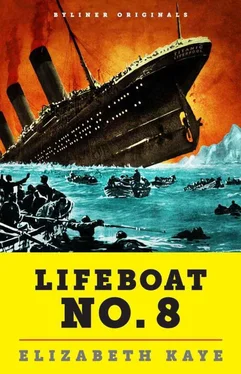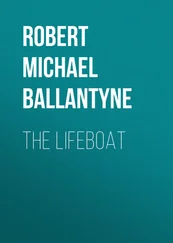LIFEBOAT NO. 8
An Untold Tale of Love, Loss, and Surviving the Titanic
By Elizabeth Kaye
At 11:40 on Sunday night, April 14, 1912, most of the 1,317 passengers aboard RMS Titanic had gone to bed, seeking warmth and refuge from the frigid night air. But several stalwart gentlemen retreated to the first-class smoking room, where the walls were paneled in lustrous mahogany inlaid with mother-of-pearl. There, sipping whiskey and playing cards, they were exemplars of a confident class lately freed from Victorian rectitude to luxuriate in Edwardian pleasures.
Suddenly they felt a heaving motion. Looking out the starboard windows, they saw something remarkable: an iceberg towering some ninety feet high. Yet, strange as it was to encounter any object on the open sea, they were neither startled nor impressed nor fazed. They watched the berg disinterestedly until the ship glided by it. Then, without comment, they resumed their game.
Did they have a moment of fear? No, they did not. For them, as for most men and women journeying in first class, the Titanic was a microcosm of life as they knew it: opulent and privileged and amply fortified against the possibility of disaster.
One player, pointing to his glass of whiskey, turned to a young steward standing nearby. “Run along the deck,” he instructed, “and see if any ice has come aboard. I would like some for this.”
At 11:45, in her lavish cabin on C Deck, Mrs. Ella White felt an odd sensation as she sat on the edge of her Queen Anne bed. She could not discern what it was, but she thought, It’s as though the ship is rolling over a thousand marbles.
In Cabin B-77, Lucy Noël Martha, Countess of Rothes, was awakened by a slight jarring followed by a distant grating sound. At thirty-three years old, with a kindly expression and manner and lucent dark eyes, the Countess was the ship’s most distinguished passenger, for amid the Titanic ’s renowned, moneyed travelers, only the Countess was renowned and moneyed and titled .
She turned on the light and glanced at the gold-and-silver clock on her dressing table. The time was 11:46 p.m. She sat up in bed, struck by the sudden stillness. Looking over at the other bed in her Regency suite, she saw that her cousin, Gladys Cherry, had just opened her eyes.
“Do you not think it strange,” asked the Countess, “that the engines have stopped?”
When the ship abruptly ceased its forward motion, Sarah Daniels awoke with a start and sprang out of bed. A buxom twenty-five-year-old, she was the personal maid to Mrs. Hudson Allison and shared a first-class cabin with Helen Loraine, the Allisons’ two-year-old daughter. After a moment’s hesitation, she knocked on the door of the adjoining cabin, where Mr. and Mrs. Allison had just fallen asleep, and said, rather timorously, that she thought the ship had encountered some trouble.
“Sarah, you’re nervous,” Mr. Allison said. “Go back to bed. This ship is unsinkable.”
The Countess wrapped herself in a floor-length silk dressing gown. She opened her cabin door and signaled to a steward walking by.
“Has something happened?” she asked.
“We’ve struck some ice,” the steward reported.
“Is there any danger?”
“Oh, no,” he said, “we have just grazed the ice, and it does not amount to anything.”
One deck below, Caroline Bonnell and her cousin Natalie Wick were nearly asleep when it seemed that the ship, so Caroline thought, gave a great shiver all through .
Minutes later they heard a woman call out, “Oh, she’s hit an iceberg!”
For Caroline and Natalie, this was thrilling news, for even at the respective ages of thirty and thirty-one, they had a childlike fascination with icebergs, which they regarded as no more threatening than a giant snowman. They had hoped to see one on their journey and were disappointed when a ship’s officer told them that the season for icebergs had passed. Now they lay beneath their eiderdown quilts debating whether to go on deck to view the berg. They yearned to see it, but Caroline had just filled a hot water bottle to warm her bed, and both were reluctant to brave the cold.
Like many first-class ladies, Mrs. William Bucknell, in Cabin D-15, shared her quarters with her maid. The widow of Bucknell University’s founder, she had been a nervous traveler ever since her son sailed on a Canadian ship that had sunk after striking an iceberg. He was saved, but that had not allayed her disquiet. Now, with the Titanic stopped dead in the water, she recalled how a fellow passenger named Molly Brown had mocked her several days earlier when she confided that she had “evil forebodings” about this voyage.
Sarah Daniels could not get back to sleep. She was convinced that something was wrong, but she was intimidated by Mr. Allison, a suave, devout Methodist who had made a fortune in the stock market, where he and his partners were known as the Methodist Mafia. She knew that she ought to believe him; she wanted to believe him. But just in case, she got dressed, dressed little Loraine, then set the child in her lap and waited.
The cabin next door to the Countess’s was occupied by her maid, Roberta Maioni, a nineteen-year-old with an angelic face and a mane of silken blond hair that flowed to her waist when loosed from its pins.
Roberta was nearly asleep when she heard someone knocking on her cabin door. “Miss, we have struck an iceberg,” a steward said. “I don’t think there’s any danger. Should there be, I’ll come back and let you know.”
It did not occur to Roberta that anything was seriously wrong. To her, the Titanic was a “fairy city… a wonder ship… a floating palace,” as it was for even the most jaded travelers on board. In such a place, nothing terrible could happen. She lay back down on the soft, cool pillow and closed her eyes.
Roberta was an English country girl, romantic and impressionable, raised in the small Surrey village of Manor Farm. For someone who regarded herself as “just a girl in my teens,” her position in the Countess’s household had provided unexpected and much-desired proximity to the reflexive indulgences of the advantaged class.
Imagine Roberta as she packed the three steamer trunks the Countess had brought on the voyage. How carefully she would have handled the newly made beaded dresses, the satin and lace lingerie, the feather boas and over-the-elbow gloves, the pearl and diamond jewelry, the tea hats with hand-dyed ostrich feathers, the furs of ermine and black fox and seal.
Imagine her as she boarded the boat train at Waterloo station with the Countess and her refined cousin Gladys Cherry, then walked with them up the wide gangway of the most fantastic ship in the world. Then picture her standing at the rail of the Boat Deck, looking out at the vast ocean, which was as magical and unconfining as her dreams.
Earlier that evening, Roberta had attended a musical event where the songs included “For Those in Peril on the Sea” and quite a few other hymns about maritime disasters. She sat with an older gentleman who had taken what she regarded as “a fatherly interest” in her. He was depressed that night, and Roberta suspected that the songs were to blame, for he was among the handful of first-class passengers who had been unnerved by what occurred moments after the Titanic set sail. Leaving the Southampton docks, the great ship had generated so much suction that the ocean liner New York was drawn away from her moorings and into the fairway. As the throng on the Titanic ’s deck looked on in mute apprehension, the New York drifted so near that the ships seemed bound to collide. Then tugboats intervened and pulled the New York away. Most passengers readily forgot the incident, but for this gentleman and several others, it was an unmistakable harbinger of ill fortune.
Читать дальше












